Introduction
This work, summarised in MAFES Bulletin 1144 (Robinson and Li 2005), provides nutritional information that can significantly reduce the cost of commercial catfish feeds. Specifically, a part of this research showed that properly balanced low-protein diets have potential for use in catfish production, (Robinson and Li 1997, 2005, 2007; Li et al. 2000, 2001, 2003a, 2003b; Robinson et al. 2001).
In addition, it may be possible to replace a major portion of soybean meal in catfish diets with less expensive feedstuffs (Robinson and Li 1993, 1994, 1999a, 1999b, 1999c, 2005; Li and Robinson 2006) or part of the corn with other less expensive energy feedstuffs (Robinson and Li 2005). Also, research on feeding catfish using high-protein finishing feeds to improve body composition and reduce feed cost has been conducted (Robinson and Jackson 1991; Robinson 1994).
Given recent increases in the price of commercial catfish feeds, additional research on reducing feed cost is warranted. The data presented in this bulletin were derived from three studies conducted over two years to further evaluate three areas: (1) low-protein, cottonseed-meal (CSM), gluten-based (corn gluten feed) diets; (2) low-corn diets; and (3) finishing diets.
Methods
General The Delta Western Research Center (DWRC) in Indianola, Mississippi, manufactured experimental diets as extruded floating pellets. DWRC manufactured fresh lots of each feed as needed. All dietary ingredients were obtained from the DWRC and were from commercial sources. All diets were formulated to meet or exceed the dietary requirements for channel catfish, with the exception of diets that were specifically formulated to contain less protein than normally considered adequate for channel catfish (NRC 1993; Robinson et al. 2001).
Fingerling channel catfish averaging 67–220 pounds per 1,000 (size varied among studies) were stocked into 0.1-acre ponds at a density of 6,000 fish per acre at DWRC. Five ponds were allotted to each dietary treatment in a complete randomized design. Fish were fed once daily to apparent satiation from mid-April to mid-October for one or two growing seasons, depending on the specific study. During the growing season, water temperature and dissolved oxygen were measured in early morning, mid-afternoon, and throughout the night. Emergency aeration was provided when dissolved oxygen levels decreased to 4 ppm.
Total ammonia-nitrogen (TAN), nitrite-nitrogen (NO2-N), and pH were measured weekly during the growing season. Water quality was maintained in ranges considered adequate for optimum fish performance (Tucker and Robinson 1990). Dead fish were removed from ponds, weighed, and recorded for correction of feed conversion ratio (FCR) at the end of the study.
Fish that were fed for two growing seasons were overwintered in their respective ponds and fed the appropriate experimental diets once or twice weekly when water temperatures exceeded 550F.

At the end of Studies 1 and 3, 30 fish from each pond were selected for subsequent processing to determine dressed yield. Fillets (one fillet per fish, 10 fish per pond) were stored at -40F for subsequent proximate analyses. After sampling, all fish from each pond were harvested, counted, and weighed. Data collected included weight gain, feed conversion ratio, survival, dressed yield, and fillet proximate composition (AOAC 2000). All data were subjected to ANOVA and the Fisher’s protected LSD procedure (Steel et al. 1997) using Statistical Analysis System version 8.0 software (SAS Institute, Inc., Cary, North Carolina, USA).
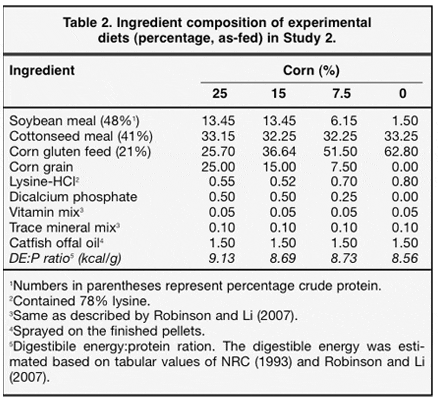
Specific Studies
Study 1: Low-protein, cottonseed-meal, and gluten-based diets — Six dietary treatments ranging from 18 per cent to 28 per cent protein with 2 per cent increments in protein between each dietary level (Table 1) were fed daily to channel catfish (initial weight = 142 pounds per 1,000 fingerlings) for two growing seasons.
Study 2: Low-corn diets — Four dietary treatments containing 0 per cent, 7.5 per cent, 15 per cent, or 25 per cent corn grain (Table 2) were fed daily to channel catfish (initial weight = 67 pounds per 1,000 fingerlings) for two growing seasons.
Study 3: Finishing diets — The following eight dietary treatments were fed to channel catfish (initial weight = 220 pounds per 1,000 fingerlings) daily for one growing season: (1) 32 per cent protein diet throughout; (2) 28 per cent protein diet throughout; (3) 24 per cent protein diet throughout; (4) 24 per cent protein diet for 60 days, and then 32 per cent protein diet for 120 days; (5) 24 per cent protein diet for 90 days, and then 32 per cent protein diet for 90 days; (6) 24 per cent protein diet for 120 days, and then 32 per cent protein diet for 60 days; (7) 24 per cent protein diet for 90 days, and then 28 per cent protein diet for 90 days; and (8) 28 per cent protein for 90 days, and then 32 per cent diet for 90 days. Commercial catfish feeds, manufactured by Delta Western Feed Mill of Indianola, Mississippi, were used in this study.
Results
Study 1: Low-Protein, CSM, and Gluten-Based Diets Based on regression analysis, there was a significant increase in weight gain and decrease in feed conversion as dietary protein increased (Table 3). Examining individual treatment means, weight gain of fish fed diets containing 18 per cent or 20 per cent protein was significantly lower than weight gains of fish fed diets containing 26 per cent or 28 per cent protein.
There were no statistical differences in weight gain of fish fed diets containing 22–28 per cent protein. Feed conversion was statistically the same for fish fed 20–28 per cent protein diets. There were no statistical differences in percentage survival among fish fed the different diets.
Regression analysis showed a significant increase in both carcass and fillet yield as dietary protein increased (Table 4). Individual means of carcass and fillet yield were highest in fish fed 26 per cent or 28 per cent protein diets. Nugget yield was unaffected by dietary protein. As dietary protein levels increased, fillet protein and moisture generally increased and fillet fat decreased (Table 5).

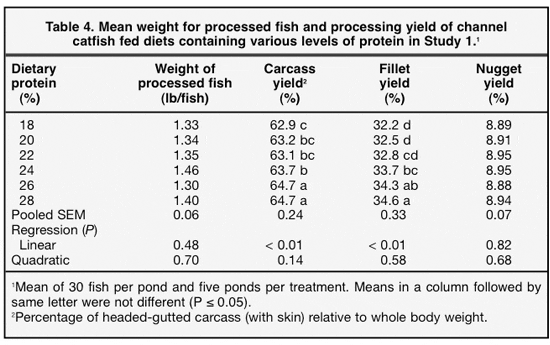
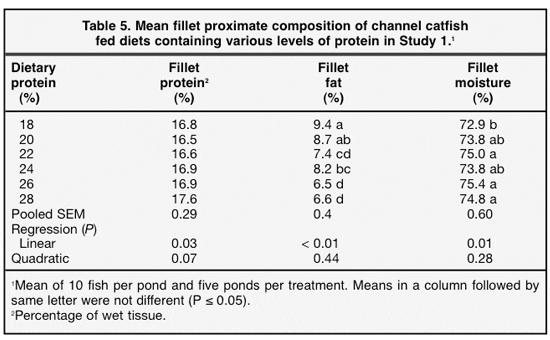
Feed consumption was higher in fish fed diets containing 0 per cent or 7.5 per cent corn grain than for fish fed diets containing higher levels of corn grain (Table 6). Weigh gain was not significantly different among diets. Feed conversion was significantly lower for fish fed diets containing 15 per cent or 25 per cent corn grain, compared with those fed diets containing lower levels of corn grain. Fish fed the diet containing no corn grain had the highest feed conversion.
Study 3: Finishing Diets There were no significant differences in weight gain among fish on the various treatments except for a reduction in weight gain in fish fed the 24 per cent protein diet throughout the growing season (Table 7).
The fish on this treatment consumed less feed and had a higher feed conversion than fish on other treatments. Fish fed the 28 per cent protein diet throughout the growing season had a significantly lower feed conversion than fish fed the 24 per cent or 32 per cent protein diet for the entire growing season or fish fed the 24 per cent protein diet for 120 days and then the 32 per cent protein diet for 60 days. However, it was not different from the feed conversion of fish on other treatments. Survival was not different among treatments.
Carcass yield was not significantly affected by dietary treatment (Table 8). Fillet yield was slightly lower for fish fed the 24 per cent protein diet throughout the growing season. There were some statistical differences in nugget yield among fish on the various treatments, but differences were small and there was no clear trend. There were no statistical differences in fillet composition of fish among treatments (Table 9).
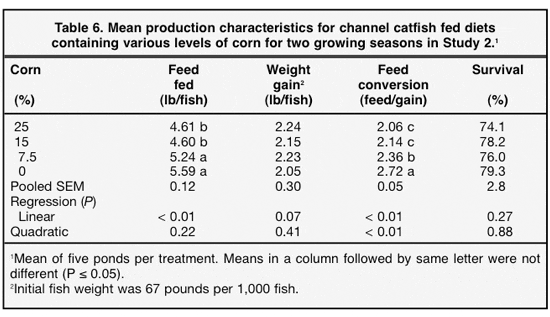
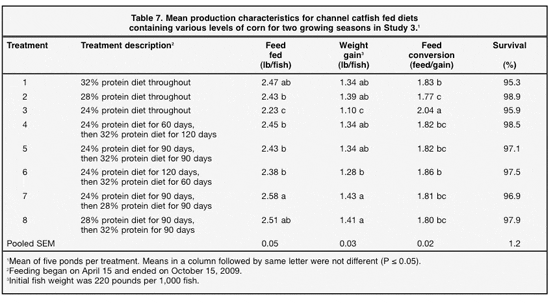
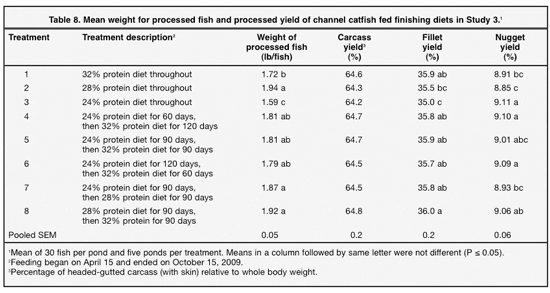
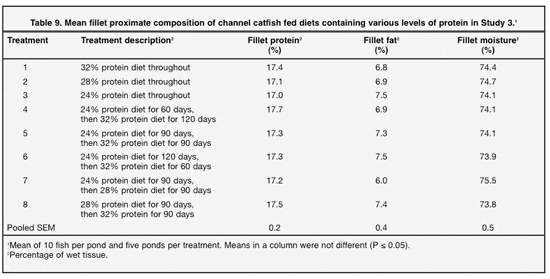
DIscussIon
Diets based on soybean meal (SBM) have typically been considered the standard in the channel catfish industry, and such diets are considered to be of “high” quality. However, other less expensive protein sources, such as CSM, are routinely used to replace part of the SBM. Based on current data, it appears that CSM can replace at least half of the SBM in catfish diets without negatively impacting fish performance (Robinson 1991; Robinson and Li 1994, 2008).
This study was not designed to compare SBM- and CSM-based diets, but to evaluate the dietary protein level that was adequate using “lower” quality diets based on CSM and corn gluten feed. However, some inference to the use of CSM in channel catfish diets can be drawn. That is, the data on low-protein, CSM, and gluten-based diets generally agree with previous studies in that CSM can be used in rather high levels in properly balanced diets for channel catfish (Robinson 1991; Robinson and Li 1994, 2008).
In regard to the primary objective, linear regression indicated a general improvement in weight gain and FCR as dietary protein increased. However, individual treatment means suggested that there was no significant difference in weight gain of fish fed 22 per cent dietary protein and those fed higher levels of protein; also, FCR was not significantly different among groups of fish fed 20–28 per cent dietary protein. These data are similar to those from a previous study on low-protein diets for catfish (Robinson and Li 1997). Based on weight gain and FCR, it would appear that diets containing as low as 22 per cent protein might be adequate for channel catfish.
However, carcass and fillet yield are generally reduced when catfish are fed lower protein diets. This is because a significant increase in body fat is typically observed in fish fed diets containing less than 28 per cent dietary protein (Robinson and Li 1997). However, Study 3 showed no statistical body fat differences in fish fed the various diets because of a high variation among ponds. The trend was that fish fed lower protein diets generally had more body fat.
Considering the negative impact on product quality if dietary protein is too low, it may be prudent to feed diets containing no less than about 28 per cent protein. However, if feed prices continue to increase and fish prices remain static, more marked changes in dietary protein may be warranted.
Corn grain has long been considered a necessity in catfish feeds primarily because it is generally a reasonably priced source of starch, which is needed to make the feed float, and it is also a relatively inexpensive source of energy. However, with the recent dramatic increase in the price of corn, there is interest in reducing the amount of corn used in channel catfish diets.
Data from the low-corn study indicated that corn could be reduced to as low as 7.5 per cent of the diet without significantly reducing weight gain. However, FCR increased in fish fed diets containing less than 15 per cent corn. Average floatability of the diets was reduced as the level of corn decreased with values of 89.7 per cent, 81.3 per cent, 52 per cent, and 30.8 per cent for diets containing 25 per cent, 15 per cent, 7.5 per cent, 0 per cent corn, respectively. It appears that the amount of corn grain should not be reduced to below about 15 per cent of the diet when using diets primarily based on CSM and corn gluten feed.
Channel catfish generally grow well when fed high-quality diets containing as little as 24 per cent protein. However, as dietary protein decreases, body fat increases, which typically decreases processing yield. A possible solution to this issue is to start the fish on a low-protein diet and then finish them on a diet containing higher levels of protein for a specified period of time before harvest.
Based on data from this study, it appears that this approach might be feasible since there was a 2−2.5 per cent increase in fillet yield for fish started on a 24 per cent protein diet and then fed a 32 per cent protein diet for 60, 90, or 120 days or a 28 per cent protein diet for 90 days.
Also, there was about a 1.3 per cent increase in fillet yield of fish fed a 28 per cent protein diet for 90 days and then finished on a 32 per cent protein diet for the last 90 days of the growing season. Even though the improvement in yield was modest, it may be of economic importance to the processor.
Another study conducted on the use of finishing diets for channel catfish did not show any benefit to using finishing diets (Robinson 1994). However, this was likely due to the fact that 28 per cent protein was the lowest level of dietary protein used in the previous study. The reduction in processed yield typically observed in channel catfish fed 28 per cent protein diets compared with fish fed higher protein diets is usually small, and in some cases there are no differences.
Weight gain and feed efficiency increased in fish finished on high-protein diets compared with those fed a 24 per cent protein diet throughout the growing season. This response was unexpected since other studies have shown that catfish grow equally well on a 24 per cent protein diet compared with fish fed diets containing higher levels of protein (Li and Lovell 1992a,b; Robinson and Li 1993).
However, this might be explained by the fact that the diets used in the earlier studies were of higher quality than the 24 per cent protein diet used in this study. Although we do not have the exact composition of the proprietary formulation that we used, we do know that it contained high levels of corn gluten feed and it did not contain animal protein.
Conclusions
- Based on weight gain and feed efficiency, channel catfish can be fed diets containing as little as 22 per cent protein; however, body fat typically increases and processing yield typically decreases in fish fed diets containing less than 28 per cent protein.
- Reducing the amount of corn grain to less than 15 per cent of the diet increased FCR in channel catfish fed CSM-, gluten-based diets. Floatability of the diet may also be reduced when corn grain is reduced to low levels.
- Starting channel catfish on a 24 per cent protein diet and feeding a higher protein diet (28 per cent or 32 per cent) for 60 to 90 days before harvest appears to be a valid strategy for maintaining body fat and processed yield in acceptable ranges.


